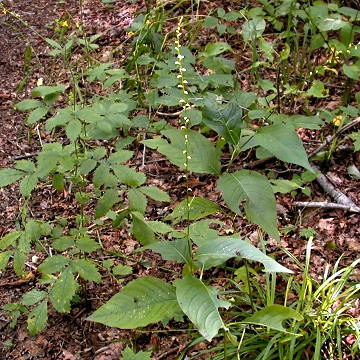

Persicaria virginiana - (image 1 of 5)
Taxonomy
Family: Polygonaceae
Synonymous with Polygonum virginianum L., Antenoron virgianum (L.) Roberty & Vautier, and Tovara virginiana (L.) Raf.
The concept of placing this species in Persicaria was first proposed by Joseph Gaertner in the late 1700's.
Habitat
Moist woodlands; wooded floodplains.
Associates
Distribution
NH west to MN and NE, south to FL and TX.
Morphology
Rhizomatous perennial to 1 m; stems often branched, erect, often with several inflorescences; ocreae pubescent and ciliate; leaves mainly cauline, lanceolate to ovate, to 15 cm, acuminate, on petioles to 2 cm; flowers greenish-white or pinkish, widely spaced on long, terminal, slender racemes; tepals 4; styles 2, elongate, persistent, becoming indurated (hardened), connivent (fused), and deflexed (bent downward) in fruit.
Notes
Flowers July to September
Wetland indicator: FAC
The name jumpseed refers to the ballistic dispersal of the seed when the stem is disturbed by animals; the hooked style of the fruit can attach to fur, further aiding in dispersal. This species tends to therefore found in areas frequented by mammals.
References
Gleason, Henry A. and A. Cronquist. 1991. Manual of Vascular Plants of Northeastern United States and Adjacent Canada. Second Ed.
The New York Botanical Garden. Bronx, NY
Swink, F. and G. Wilhelm. 1994. Plants of the Chicago Region.
Indiana Academy of Science. The Morton Arboretum. Lisle, Illinois.
|
Michael Hough © 2010 |